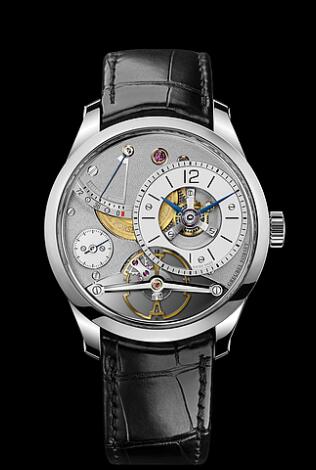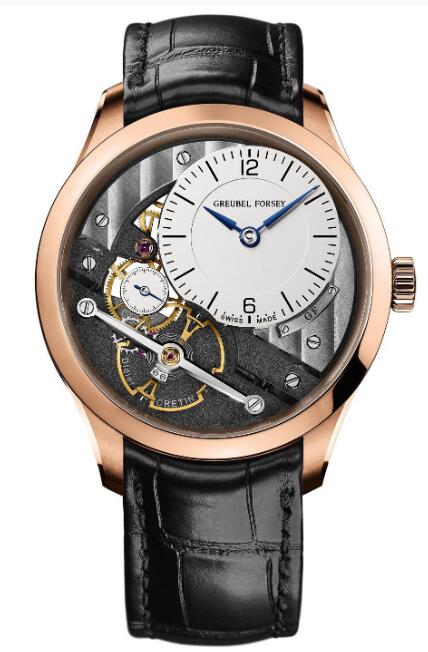Double tourbillon 30 degree technical ceramic

The top watchmaker Greubel Forsey showed their original invention, the Double Tourbillion, for the first time in a ceramic case. The Double Tourbillon 30° technical ceramic is limited to 11 pieces and is made of blue ceramic. Sapphire crystal is added to all parts of the movement, which can provide more light than the previous version.
The top watchmaker Greubel Forsey showed their original invention, the Double Tourbillion, for the first time in a ceramic case. The Double Tourbillon 30° technical ceramic is limited to 11 pieces and is made of blue ceramic. Sapphire crystal is added to all parts of the movement, which can provide more light than the previous version.
The complexity of the Double Tourbillon 30° tourbillon remains unchanged, ensuring high accuracy. A cage completely rotates every four minutes, while a smaller cage equipped with a balance wheel and spring is tilted 30° relative to the larger cage, completing a rotation every 60 seconds. The combination of 30° inclination and different speeds of the two tourbillons can improve the timing function by averaging the position error caused by gravity.
The manual-winding 3Hz movement measures 38.40 mm x 12.15 mm and has 421 components, a 120-hour power reserve, and 43 gold gemstones inlaid with olive gold. Four coaxial coaxial fast rotating barrels (1 rotating in 3.2 hours) provide power for the power reserve, one of which is equipped with a sliding spring to avoid excessive tension, the case is equipped with a 22k gold case, and Nickel palladium treatment and relief. Many parts are now sapphire, which allows more light to pass through, especially to enhance the vision of the double tourbillon at work. Some traditional materials have been retained in previous iterations of the movement, including nickel silver, polished bevels and holes frosted, straight tooth flanks and nickel palladium treatment.
Equipped with this movement is a new blue ceramic case, its size is negligible, 48.40 mm x 17.77 mm, but because of the ceramic material, it is lighter than the previous version. The crown is also ceramic and engraved with the GF logo. The back cover, bezel and strap are made of a piece of ceramic, polished and straight grained, and finished by hand.

Hands-on with Graubel Fauci’s artwork 1
High-end timepieces are often compared with works of art due to their creative nature, that is, components require skilled technicians to make by hand, finishing, and sometimes the dial even has miniature paintings (called enamel works). Not to mention that this class of watches is only sold in limited quantities.
Well, Greubel Forsey fake took this idea a step further with “Work of Art 1”, a very limited series of watches inlaid with artwork by nano-engraving artist Williard Wigan.
In a recent discussion with the brand co-founder Stephen Forsey, he told “Professional Watch” that in order to correctly observe the needle-sized nano sculptures that need to be engraved, they must create a special lens system with a size Should be small enough to fit inside. Crown, but sharp enough to properly enlarge the sculpture. The result is an internal lens with a ring at the end of the crown that can adjust the magnification and focus level according to the user’s preferences.
Of course, there is also a timing element. However, instead of the traditional hour and minute display, the time is provided on demand by pressing the button at 4 o’clock on the strap. Press the button to open and turn the aperture on the dial. The arrow at the top of the aperture indicates the hour, and the red arrow at the bottom indicates the minute. Since it is Greubel Forsey, it naturally needs a tourbillon. In this case, it is a 30° tilted double tourbillon, located between 12 o’clock and 3 o’clock.
The combination of miniature works of art and micromechanics is the perfect combination of two forms of art. Both art forms require skilled craftsmen. The level is so small that they are beyond the scope of the naked eye.
Hands-on use Greubel Forsey GMT Black
In 2011, Greubel Forsey launched GMT. This timepiece surpasses the traditional second time zone watch. It combines a globe that can complete each counterclockwise rotation within 24 hours, which is the same as the rotation direction of our planet. Today, before the official debut of SIHH 2015, we bring you an exclusive hands-on practice of the latest version of GMT Black.
GMT Black uses the same asymmetrical shape as the original model case (43.5mm x 16.14mm), but is now made of ultra-light titanium metal with a vacuum-deposited black ADLC coating. Although Greubel Forsey does not have the exact weight available, in my hands, the gold version weighs about twice the weight of titanium.
The amorphous diamond-like carbon (ADLC) coating is much harder than natural titanium and is highly scratch resistant. The tops of the case and lugs have shiny black surfaces, while the sides and back of the case are treated with satin matte, creating a subtle contrast.
Like the original factory, the GMT Black is powered by a manually wound GF5 movement. It has two barrels connected in series and can provide a 72-hour power reserve at a frequency of 3 Hz. The movement has a total of 443 components. It has a patented 24-second tourbillon with a 25° inclination, including 87 parts, and a total weight of 0.36 grams. Shopping copy watches
Although the movement is technically the same, the motherboard and bridge have adopted a new black finish. In addition, the palette of dials and components are more restricted, which helps to create a contrast between the different textures and surface finishes of the decoration of each component.
Speaking of decoration, this is one of Greubel Forsey’s characteristics. Hand-made decorations include frosted, hand-beveled, hand-polished, grinded and straight grained, with pure black polishing.
Functionally, everything is the same: the main time is displayed on the large dial at the top, while the small second hand is displayed at 3 o’clock. The power reserve indicator is located next to the seconds display. The time is controlled by the crown, and the global time is a 24-hour system.
9 o’clock is the second time zone (12 hours), controlled by the push stick on the left side of the time zone. The push rod is also used when reading the 24-hour time displayed around the earth. A world time dial is displayed on the bottom cover, which is directly coordinated with the earth.
Stephen Forsey explained that instead of a traditional leather strap, a custom synthetic strap was made to match the movement characteristics of the Review copy watches while providing a leather-like feel.
